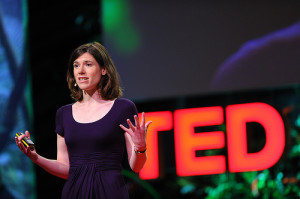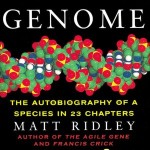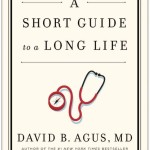From TED.com
What is killing the Tasmanian devil? A virulent cancer is infecting them by the thousands — and unlike most cancers, it’s contagious. Researcher Elizabeth Murchison tells us how she’s fighting to save the Taz, and what she’s learning about all cancers from this unusual strain. Contains disturbing images of facial cancer.
Elizabeth Murchison studies a mysterious (and contagious) cancer that threatens to wipe out Tasmanian devils.
Why you should listen
Elizabeth Murchison grew up in Tasmania, the island home of the small, aggressive marsupial known as the Tasmanian devil. In the mid-’90s, the devils were beset with a terrible new disease — a contagious facial cancer, spread by biting, that killed the animals just as they reached breeding age. By 2008, half the devil population of Australia had contracted the cancer and died. And as Murchison says: “I didn’t want to sit back and let the devils disappear.”
Leading an international team at Cold Spring Harbor Laboratory, she worked to understand why this cancer was so virulent — with the goal of saving the Taz, as it is called, but also of understanding how a contagious cancer works. Analyzing gene and microRNA activity in 25 different facial tumors and in healthy tissue, the team found that cancers from animals across Tasmania were identical, and that the cancer stems from Schwann cells, which normally insulate nerve fibers.
Now a Research Fellow in Medical Sciences at King’s College, Cambridge, Murchison is using high-throughput DNA sequencing technologies to investigate the genetics and evolution of this disease, one of only three known cancers that spread contagiously.
She says: “This is why cancer is such a difficult disease to treat: It evolves.”
What others say
“The devils will eventually need a vaccine, and there is hope that this research may help scientists develop one.” — Bryan Walsh, Time magazine
Now watch her video :
TITLE: Elizabeth Murchison: Fighting a contagious cancer
TEDGlobal 2011 · 13:03 minutes · Filmed Jul 2011
See more at TED.com
~~~~~~~~~~~~~~ Or Read the Transcript from TED ~~~~~~~~~~~~~~
0:15 Everyone’s familiar with cancer, but we don’t normally think of cancer as being a contagious disease. The Tasmanian devil has shown us that, not only can cancer be a contagious disease, but it can also threaten an entire species with extinction.
0:36 So first of all, what is a Tasmanian devil? Many of you might be familiar with Taz, the cartoon character, the one that spins around and around and around. But not many people know that there actually is a real animal called the Tasmanian devil, and it’s the world’s largest carnivorous marsupial. A marsupial is a mammal with a pouch like a kangaroo. The Tasmanian devil got its name from the terrifying nocturnal scream that it makes.
1:04 (Screaming)
1:15 (Laughter)
1:17 The Tasmanian devil is predominantly a scavenger, and it uses its powerful jaws and its sharp teeth to chomp on the bones of rotting dead animals. [The] Tasmanian devil is found only on the island of Tasmania, which is that small island just to the south of the mainland of Australia. And despite their ferocious appearance, Tasmanian devils are actually quite adorable little animals. In fact, growing up in Tasmania, it always was incredibly exciting when we got a chance to see a Tasmanian devil in the wild.
1:51 But the Tasmanian devil population has been undergoing a really extremely fast decline. And in fact, there’s concern that the species could go extinct in the wild within 20 to 30 years. And the reason for that is the emergence of a new disease, a contagious cancer.
2:13 The story begins in 1996 when a wildlife photographer took this photograph here of a Tasmanian devil with a large tumor on its face. At the time, this was thought to be a one-off. Animals, just like humans, sometimes get strange tumors. However, we now believe that this is the first sighting of a new disease, which is now an epidemic spreading through Tasmania. The disease was first sighted in the northeast of Tasmania in 1996 and has spread across Tasmania like a huge wave. Now there’s only a small part of the population, which remains unaffected.
2:52 This disease appears first as tumors, usually on the face or inside the mouth of affected Tasmanian devils. These tumors inevitably grow into larger tumors, such as these ones here. And the next image I’m going to show is quite gruesome. But inevitably, these tumors progress towards being enormous, ulcerating tumors like this one here.
3:16 This one in particular sticks in my mind, because this is the first case of this disease that I saw myself. And I remember the horror of seeing this little female devil with this huge ulcerating, foul-smelling tumor inside her mouth that had actually cracked off her entire lower jaw. She hadn’t eaten for days. Her guts were swimming with parasitic worms. Her body was riddled with secondary tumors. And yet, she was feeding three little baby Tasmanian devils in her pouch. Of course, they died along with the mother. They were too young to survive without their mother. In fact, in the area where she comes from, more than 90 percent of the Tasmanian devil population has already died of this disease.
4:02 Scientists around the world were intrigued by this cancer, this infectious cancer, that was spreading through the Tasmanian devil population. And our minds immediately turned to cervical cancer in women, which is spread by a virus, and to the AIDS epidemic, which is associated with a number of different types of cancer. All the evidence suggested that this devil cancer was spread by a virus. However, we now know — and I’ll tell you right now — that we know that this cancer is not spread by a virus. In fact, the infectious agent of disease in this cancer is something altogether more sinister, and something that we hadn’t really thought of before. But in order for me to explain what that is, I need to spend just a couple of minutes talking more about cancer itself.
4:51 Cancer is a disease that affects millions of people around the world every year. One in three people in this room will develop cancer at some stage in their lives. I myself had a tumor removed from my large intestine when I was only 14. Cancer occurs when a single cell in your body acquires a set of random mutations in important genes that cause that cell to start to produce more and more and more copies of itself. Paradoxically, once established, natural selection actually favors the continued growth of cancer. Natural selection is survival of the fittest. And when you have a population of fast-dividing cancer cells, if one of them acquires new mutations, which allow them to grow more quickly, acquire nutrients more successfully, invade the body, they’ll be selected for by evolution.
5:44 That’s why cancer is such a difficult disease to treat. It evolves. Throw a drug at it, and resistant cells will grow back. An amazing fact is that, given the right environment and the right nutrients, a cancer cell has the potential to go on growing forever. However cancer is constrained by living inside our bodies, and its continued growth, its spreading through our bodies and eating away at our tissues, leads to the death of the cancer patient and also to the death of the cancer itself.
6:22 So cancer could be thought of as a strange, short-lived, self-destructive life form — an evolutionary dead end. But that is where the Tasmanian devil cancer has acquired an absolutely amazing evolutionary adaptation. And the answer came from studying the Tasmanian devil cancer’s DNA. This was work from many people, but I’m going to explain it through a confirmatory experiment that I did a few years ago.
6:51 The next slide is going to be gruesome. This is Jonas. He’s a Tasmanian devil that we found with a large tumor on his face. And being a geneticist, I’m always interested to look at DNA and mutations. So I took this opportunity to collect some samples from Jonas’ tumor and also some samples from other parts of his body. I took these back to the lab. I extracted DNA from them. And when I looked at the sequence of the DNA, and compared the sequence of Jonas’ tumor to that of the rest of his body, I discovered that they had a completely different genetic profile. In fact, Jonas and his tumor were as different from each other as you and the person sitting next to you. What this told us was that Jonas’ tumor did not arise from cells of his own body. In fact, more genetic profiling told us that this tumor in Jonas actually probably first arose from the cells of a female Tasmanian devil — and Jonas was clearly a male.
7:55 So how come a tumor that arose from the cells of another individual is growing on Jonas’ face? Well the next breakthrough came from studying hundreds of Tasmanian devil cancers from all around Tasmania. We found that all of these cancers shared the same DNA. Think about that for a minute. That means that all of these cancers actually are the same cancer that arose once from one individual devil, that have broken free of that first devil’s body and spread through the entire Tasmanian devil population.
8:30 But how can a cancer spread in a population? Well the final piece of the puzzle came when we remember how devils behave when they meet each other in the wild. They tend to bite each other, often quite ferociously and usually on the face. We think that cancer cells actually come off the tumor, get into the saliva. When the devil bites another devil, it actually physically implants living cancer cells into the next devil, so the tumor continues to grow. So this Tasmanian devil cancer is perhaps the ultimate cancer. It’s not constrained by living within the body that gave rise to it. It spreads through the population, has mutations that allow it to evade the immune system, and it’s the only cancer that we know of that’s threatening an entire species with extinction.
9:14 But if this can happen in Tasmanian devils, why hasn’t it happened in other animals or even humans? Well the answer is, it has. This is Kimbo. He’s a dog that belongs to a family in Mombasa in Kenya. Last year, his owner noticed some blood trickling from his genital region. She took him to the vet and the vet discovered something quite disgusting. And if you’re squeamish, please look away now. He discovered this, a huge bleeding tumor at the base of Kimbo’s penis. The vet diagnosed this as transmissible venereal tumor, a sexually transmitted cancer that affects dogs. And just as the Tasmanian devil cancer is contagious through the spread of living cancer cells, so is this dog cancer.
10:08 But this dog cancer is quite remarkable, because it spread all around the world. And in fact, these same cells that are affecting Kimbo here are also found affecting dogs in New York City, in mountain villages in the Himalayas and in Outback Australia. We also believe this cancer might be very old. In fact, genetic profiling tells that it may be tens of thousands of years old, which means that this cancer may have first arisen from the cells of a wolf that lived alongside the Neanderthals. This cancer is remarkable. It’s the oldest mammalian-derived life form that we know of. It’s a living relic of the distant past.
10:54 So we’ve seen that this can happen in animals. Could cancers be contagious between people? Well this is a question which fascinated Chester Southam, a cancer doctor in the 1950s. Ad he decided to put this to the test by actually deliberately inoculating people with cancer from somebody else. And this is a photograph of Dr. Southam in 1957 injecting cancer into a volunteer, who in this case was an inmate in Ohio State Penitentiary. Most of the people that Dr. Southam injected did not go on to develop cancer from the injected cells. But a small number of them did, and they were mostly people who were otherwise ill — whose immune systems were probably compromised.
11:46 What this tells us, ethical issues aside, is that … (Laughter) it’s probably extremely rare for cancers to be transferred between people. However, under some circumstances, it can happen. And I think that this is something that oncologists and epidemiologists should be aware of in the future.
12:13 So just finally, cancer is an inevitable outcome of the ability of our cells to divide and to adapt to their environments. But that does not mean that we should give up hope in the fight against cancer. In fact, I believe, given more knowledge of the complex evolutionary processes that drive cancer’s growth, we can defeat cancer. My personal aim is to defeat the Tasmanian devil cancer. Let’s prevent the Tasmanian devil from being the first animal to go extinct from cancer.
12:49 Thank you.
12:51 (Applause)
If you like this story, CLICK HERE to join the tribe of success-minded people just like you. You will love our weekly quick summaries of top stories, talks, books, movies, music and more with handy downloadable guides, cheat sheets, cliffs notes and quote books.
And, you can opt-out at any time – no strings, promise… CLICK HERE


















